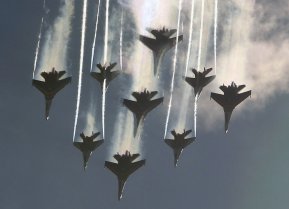Flanker: The Russian Fighter Jet That Could Wage War Everywhere
Here is a guide to the most important Flanker derivatives.
In addition to being larger, the Su-34 is distinguished by its heavily swept canards, its flatter ‘platypus’ style nose which houses a V004 PESA radar, and a distinctive humped neck supporting an enlarged cockpit—which allows its two-person crew to side-by-side for comfort. The Su-34 is intended to fly long-range missions lasting up to ten hours at a time, (the maximum 2,500 mile can be greatly extended by inflight refueling) so its pilots have space to sleep, use a toilet and eat from a galley.
The huge Flanker-derivative can carry up to thirteen tons of weapons on twelve pylons, including anti-radar missiles, long and short-range air-to-air missiles, supersonic Oniks anti-shipping cruise missiles, and conventional dumb bombs and rockets. A rear-facing radar even allows the Fullback to detect enemy fighters closing from behind and launch missiles at them. Though its greater weight results in a slower maximum speed of Mach 1.8 (or 1.2 at low altitude), the Fullback remains just supermaneuverable like other Flankers.
In vogue during the 70s and 80s, low-altitude penetration is an increasingly risky tactic due to improvements to air- and ground-based radars and surface-to-air missile systems. With survivability in mind, the Fullback’s cockpit is enclosed in an ‘armored bathtub’ of 17mm of titanium, while an L175 Khibiny electronic warfare system is designed to distort enemy missiles.
Russia has so far procured 114 Fullbacks out of a planned 200, and has used them to bomb rebels in Syria, mostly using unguided bombs, though its PLATAN laser-targeting system gives it precision-attack capability lacking in most Russian fighters. Algeria is the only other Su-34 operator.
The Su-35S ‘Flanker E’: The Ultimate Flanker
Back in 2003, KnAAOP began developing the ultimate single-seat multirole Flanker. The resulting Su-35S now features three-dimensional AL41FS turbofans that can tilt up and down as well as sideways to give extraordinary maneuverability, as you can see in this video. Designers also modestly reduced the Su-35S’s radar cross section to around 1–3 meters squared, increased the number of hardpoints to fourteen, and ensured compatibility with the latest precision-guided munitions and long-range air-to-air missiles such as the R-77. The Su-35S also boasts the Khibiny ECM system and a long-range IRST.
The Flanker-E appears to have a slight edge over the F-15 in terms of weapons load, defensive countermeasures and short-range dogfighting. However, modernized F-15s do boast superior Active Electronically Scanned Array (AESA) radars that are harder to detect and have higher resolution. The Su-35’s Irbis-E radar has very long range (maximum 250 miles) and can scan for ground and air targets; however, it’s sheer power makes it quite indiscrete on enemy radars.
Though pricey compared to earlier Russian fighters, Su-35s have been purchased by Sudan and Indonesia. China also has acquired twenty-four Su-35s, likely in order to reverse-engineer their turbofans. The Russian air force has acquired around seventy Su-35s out of 100 on order, and deployed several to Syria. There, they escorted Russian bombers, played games of chicken with U.S. fighters, and dropped bombs on Syrian rebels—though reportedly their radars had difficulty accurately guiding them.
The latest Flanker highlights the divergence in American and Russian air combat doctrine. The U.S. military believes speed, stealth and long-range weaponry trump maneuverability—especially as tight maneuvers like the Cobra bleed off prodigious energy, leaving a fighter unable to evade follow-on attacks. Russia continues to build highly maneuverable jets, believing that electronic warfare will reduce the kill-rate of beyond-visual range missiles, while arguing that ground-based low-bandwidth radars will help vector its fourth-generation fighters into range of stealthy adversaries. However, as AESA-radar equipped stealth fighters would see them coming from further away, this could be a difficult strategy to pull off.
Sébastien Roblin holds a Master’s Degree in Conflict Resolution from Georgetown University and served as a university instructor for the Peace Corps in China. He has also worked in education, editing, and refugee resettlement in France and the United States. He currently writes on security and military history for War Is Boring.
This article first appeared in May 2018.
Image: Wikimedia Commons


